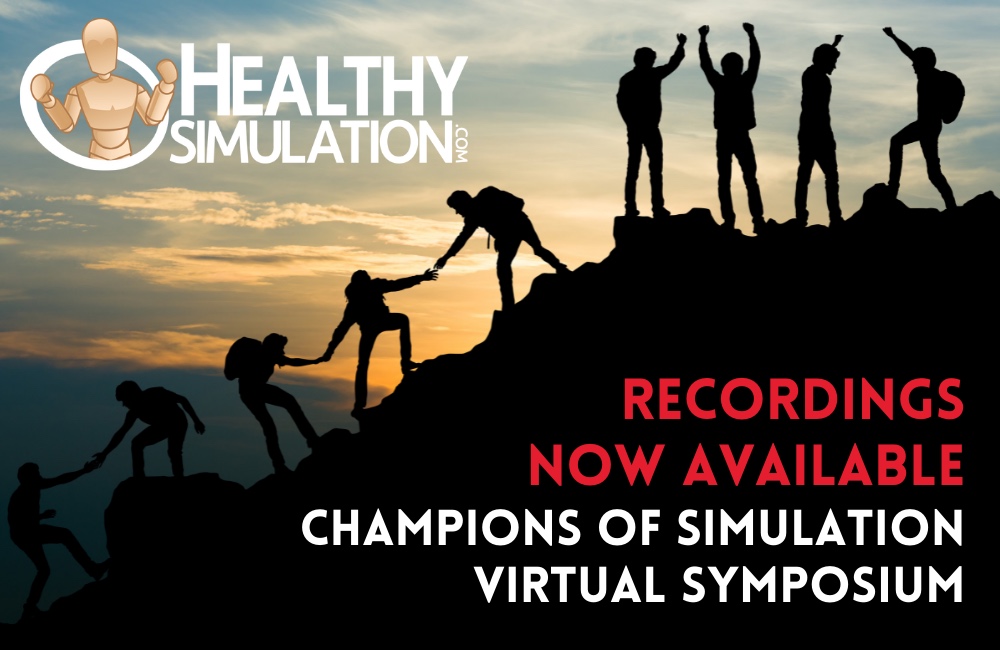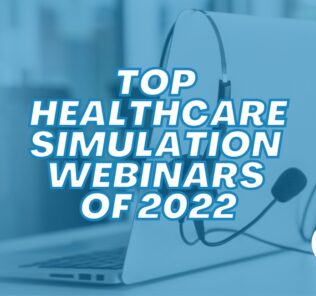Recap: Champions of Simulation Virtual CE/CME Symposium 2022 – Recordings Now Available
Simchamps, HealthySimulation.com is proud to announce that the first-ever Champions of Simulation Virtual CE/CME Symposium was a success! As the world’s leading healthcare simulation resource website, we are extremely grateful to all those who took the time to present, and those who joined us as participants. Together, the insight that was shared through this incredible event brought together so many of the industry’s movers-and-shakers, helping us advance together toward a future that prioritizes clinical simulation in a way like never before. This HealthySimualtion.com article shares some of the highlights from the event. All recordings are currently available for viewing upon purchased registration.
Leading off the event, Robert G. Louis, MD, FAANS, Chief of Neurosurgery and Director of Extended Reality (XR) Development at the Pickup Family Neurosciences Institute at Hoag Memorial Hospital, shared his presentation, “It Isn’t Brain Surgery: Using Simulation to Improve Patient Conversion, Understanding, Outcomes and Satisfaction.” During this discussion, which provides 1 Nursing CE Certificate Contact Hour, Louis noted current problems with traditional imaging systems and described how advanced medical visualization systems can solve them.
“Surgeons, like athletes, have what we call flow,” Louis said. “Every time we have to break attention from what we’re doing and focus on something else, we lose the flow. It distracts us because of context switching. With AR, I have this heads-up display that allows me to increase spatial awareness and maintain focus on the patient the entire time.”
Sponsored Content:
Next, during the Industry Panel Discussion, insights from leading global vendors were shared. Together, Lynn Welch, Vice President of Business Development & Marketing at Education Management Solutions, and Amar Patel, DHSC, MS, NRP, CHSE, FSSH, Chief Learning Officer at CAE Healthcare, advancements in the global use of technologies – such as those developed by their respective companies.
“We’ve seen a fascinating acceleration in the adoption of simulation. Something that would have taken years and years to the point [of adoption], was all accelerated during COVID,” Welch explained. “We always try to find the silver lining – while COVID was very challenging for everyone globally, it has probably done more to accelerate how healthcare will be practiced tomorrow than anything else could have.”
“One thing we’ve seen certainly accelerate in the last two years are learning paths. The notion of frameworks [across other facets of healthcare] arent the same frameworks that we need to consider in the education and training space,” Patel added. “For us, the biggest change has been looking at how journeys of an individual can be accelerated.”
Another incredibly important topic, “Advancing the Global Clinical Simulation Industry” was addressed during a special session. During this presentation, Elizabeth Hyman, the Chief Executive Officer of the XR Association (XRA), discussed securing the limitless future of the XR industry. In doing this, XRA provides a forum for industry networking and collaboration to assist the progress and development of the XR industry.
Sponsored Content:
“How do we make our devices safe and ergonomic? How do we make sure that in shared immersive spaces feel inclusive, welcoming, and safe?” Hyman asked. “There are techniques and practices that can help to achieve that. We also created a best practices guide on accessibility. The disability community is probably one of the best-untapped workforce resources out there, and this technology more than many, will help to provide opportunities for all abilities.”
Also in terms of advancing the scope of healthcare simulation to best support patients, learners, and professionals, the panel discussion titled “Is It Time for a National Patient Safety Board?” shared why the development of such a committee is essential moving forward. Karen Feinstein, President, and CEO of the Jewish Healthcare Foundation noted that patient safety differs from aviation safety in that patients tend to care more about what’s happening in their local area.
“There’s another organization called CAST – the Commercial Aviation Safety Team. CAST is a lot like what we’re trying to create,” Feinstein explained. “The NTSB does incident investigations. They’re fortunate enough that when they have a major incident, like a crash, they can spend a lot of time on one incident and all the particulars. [Healthcare] has a greater issue, because [these] incidents are happening every minute somewhere.”
She further explained that alternatively, CAST looks at the preconditions for harm, and is focused more generally. The goal is to prevent this harm before it occurs. Feinstein shared that the more she and her team learned about CAST, the more they saw room for alignment. This includes a level of research and investigation that she believes is much needed in healthcare, and as an industry/government collaborative partnership potential solutions would be vetted before being released to the general public and stakeholders.
When comparing airlines and healthcare, Pam Boyers, Ph.D., MA, the Associate Vice Chancellor of Clinical Simulation at iEXCEL at the University of Nebraska Medical Center (UNMC), highlighted that another difference is apparent through comparing crew and staff. Crew members on a plane stay together during a flight’s entirety, whereas many patients (especially those staying in hospitals for a number of days) will come to see a variety of staff members.
“They can change levels of care four to five times during that period of being in the hospital,” Boyers stressed. “The literature on patient safety tells us that patients are most vulnerable at the handoff of care. And where does that get practiced? Where does that get taught? How do you handoff people carefully from one level of care to another?”
Additional Notes from the Recorded Event
- Dr. Robert Louis began his keynote presentation by sharing some of his background and providing a historical perspective on the first reported case of surgery for a cerebral tumor. He says this led to the discovery of possible interventions for the human brain. Next came Magnetic Resonance Imaging. With exponential access to technological advancements such as these, he notes the benefits of today’s virtual reality capabilities allowing surgeons to experience a case in advance. It’s individual patient outcomes that are the most important outcomes of all, he says.
- Next, Lynn Welch shared how COVID-19 has allowed for an increasing number of healthcare simulation communities to come together on a global basis. Dr. Amar Patel, DHSc, MS, NRP, CHSE, FSSH, added that the biggest change has been adapting to meet the need to get learners from point A to point B quickly. On this note, they believe programs of tomorrow will work closely with healthcare partnerships to look at patient safety and treatment challenges from a regional perspective, versus looking to meet graduation rates solely. Patel said we must move away from a teacher-centered learning style, and focus more on the individual.
- In track A2, “Streamlining Competency-Based Assessment and Curriculum Mapping Within Your Simulation Program,” Melissa Helvey, discussed Competency. AI. She notes that through this platform, educators have the ability to track learner performance and understand exactly where students are falling short.
- In track B2, “Benchmarking, Metrics, and Data: Why It Matters for Healthcare Simulation,” Phillip Wortham, MBA, BA, CHSOS-A, addressed the importance of collecting meaningful data. He explained the difference between metrics and data. He moved into discussing the operation needs assessment, and what goes into planning for the future and ROI.
- During the first panel discussion, “Is It Time for the Healthcare Simulation Industry to Call for a National Patient Safety Board?” Paul Phrampus, MD, FSSH FACEP, KT Waxman, DNP, MBA, RN, CNL, CHSE, CENP, FAONL, FSSH, FAAN, Pam Boyers, Ph.D., MA, and Karen Wolk Feinstein, Ph.D., emphasize the need to prevent patient harm before it occurs. Specifically, Feinstein shared that more AI needs to be deployed to advance safety technology. Waxman added that regulators must come to recognize clinical simulation learning as a new standard, especially as virtual simulation is cost-effective. To do this, healthcare simulation successes must be shared publicly through data. Phrampus further explained that to increase successful patient safety outcomes, there must be incentives and adequate staffing – which there normally isn’t. Lastly, Boyers noted that using the airline/black box analogy, people can elect to fly – they cannot always elect to have healthcare services performed. That is why her simulation center has come to see training as the highest priority.
- In her presentation, “Creating A Simulation Center Costing Model, Can You Afford Not To?” Kerri Oshust, MRT (MR), MBA, the Director at the Centre for, Advanced Medical Simulation at the Northern Alberta, Institute of Technology, discussed why a costing model is needed. Reasons include that it accounts for all organizational costs from bricks and mortar to equipment to labor. Additionally, a costing model enables simulationists to search for cost reduction opportunities and prevents “accidental” loss. Other reasons include that it enhances negotiation abilities and allows for rapid customer response time and accurate quotes.
Between all of these topics, presentations, and the various presenters, attendees of SIMCHAMPS22 were faced with just as many questions as answers. Yet, the conversations had are what is going to help our industry to be able to better identify means for constant improvement. Did you attend the virtual symposium and have feedback for HealthySimulation.com? Please email support@healthysimulation.com and let us know!
List of Participating World Renown Clinical Simulation Champion Presenters Included:
- (Keynote Presenter) Robert Louis, MD, FAANS: Chief of Neurosurgery, Director of Extended Reality (XR), Pickup Family Neurosciences Institute at Hoag Memorial Hospital
- Paul Phrampus, MD, FSSH FACEP: Director at WISER Center & Medical Director of Patient Safety at UPMC, Past President at Society for Simulation in Healthcare
- KT Waxman, DNP, MBA, RN, CNL, CHSE, CENP, FAONL, FSSH, FAAN: Clinical Professor & Director at UC San Francisco, Director at the California Simulation Alliance
- Amar Patel, DHSc, MS, NRP, CHSE, FSSH: Chief Learning Officer at CAE Healthcare, Former Director at WakeMed Simulation Center
- Adam Cheng, MD, FRCPC: Professor, Department of Pediatrics at The University of Calgary
- Suzie Kardong-Edgren, PhD, RN, ANEF, CHSE, FSSH, FAAN: Associate Professor at MGH Institute of Health Professions, President of INACSL
- Lynn Welch: Vice President of Business Development & Marketing at Education Management Solutions, Past Chair, Society for Simulation in Healthcare Corporate Round Table
- Ariana Longley, MPH: Chief Operating Officer at the Patient Safety Movement Foundation
- Pam Boyers, PhD, MA: Associate Vice Chancellor, Clinical Simulation at iEXCEL at the University of Nebraska Medical Center (UNMC)
- Kellie Bryant, DNP, WHNP, CHSE, FAAN: Assistant Dean for Clinical Affairs & Nursing Simulation, and Associate Professor at Columbia University School of Nursing
- Debra Nestel, PhD, FAcadMed FSSH: Prof. of Simulation at Monash University, Prof. of Surgical Ed at Uni. of Melbourne, Founding Editor-in-Chief, International Journal of Healthcare Simulation
- Kerri Oshust, MRT (MR), MBA: Director at the Centre for, Advanced Medical Simulation at the Northern Alberta, Institute of Technology
- Scott Crawford, MD, FACEP, CHSOS: Executive Director, Training and Educational Center for Healthcare Simulation at Texas Tech University Health Sciences Center El Paso
- Crystal L. Murillo, PhD, RN, CHSE-A: Assistant Professor and Director of the Center for Simulation and Experiential Learning at the University of South Carolina College of Nursing
- AnneMarie Monachino, DNP, RN, CPN, CHSE-A, NPD-BC: Senior Simulation Educator and Nursing Professional
Development Specialist at Children’s Hospital of Philadelphia - Desiree A. Diaz, PhD, FNP-BC, CNE, CHSE-A, ANEF, Associate Professor, College of Nursing, and Simulation Coordinator at University of Central Florida
Participating Non-Profit Organizations Include: International Nursing Association of Clinical and Simulation Learning (INACSL), National Patient Safety Board (NPSB), The Gathering Of Healthcare Simulation Technology Specialists (SimGHOSTS), The Winter Institute for Simulation, Education, and Research (WISER) | Supporting Commercial Partners Include: Education Management Solutions (EMS), CAE Healthcare, The Debriefing Academy
More About HealthySimulation.com
HealthySimulation.com is the world’s premier Healthcare Simulation resource website, providing the latest news, conference coverage, research highlights, helpful guides, job listings, product demos, vendor contacts, community sharing, and more! Started in 2010 by Lance Baily, the resource has provided well over 2,000,000 page views of medical simulation-specific content through thousands of daily articles to hundreds of thousands of healthcare professionals from around the globe. The HealthySim writing team has shared their passion for simulation in healthcare by writing an article every workday, Monday-Friday for over thirteen years.
Get Instant Access to the Champions of Simulation Virtual Symposium Recorded Sessions!
Lance Baily, BA, EMT-B, is the Founder & CEO of HealthySimulation.com, which he started while serving as the Director of the Nevada System of Higher Education’s Clinical Simulation Center of Las Vegas back in 2010. Lance is also the Founder and acting Advisor to the Board of SimGHOSTS.org, the world’s only non-profit organization dedicated to supporting professionals operating healthcare simulation technologies. His co-edited Book: “Comprehensive Healthcare Simulation: Operations, Technology, and Innovative Practice” is cited as a key source for professional certification in the industry. Lance’s background also includes serving as a Simulation Technology Specialist for the LA Community College District, EMS fire fighting, Hollywood movie production, rescue diving, and global travel. He and his wife Abigail Baily, PhD live in Las Vegas, Nevada with their two amazing daughters.
Sponsored Content:



















